Sala–Franch house
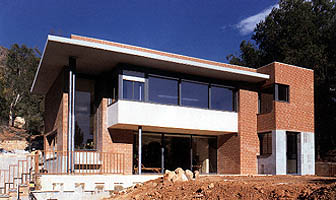
Cheluca Sala Palau
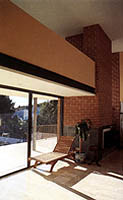
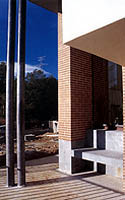
| Casa Sala–Franch Sala–Franch house |
|||||
 |
Arquitectos/Architects: Cheluca Sala Palau |
 |
 |
– Vivienda permanente de tamaño mediano en la periferia para un matrimonio joven dedicado a la medicina. Existe Carlitos. Es una casa para vivir y para estudiar. También es una casa para jugar. El programa es vivir, dormir, jugar y trabajar. Se explica en la sección.–El lugar, como siempre, es el que marca las reglas del proyecto. En la parcela lo primero era definir un suelo, los distintos planos de apoyo y sus límites. –Las directrices: Relación de la casa con el monte y ubicación de la casa en la parcela, de modo que fuese elemento articulador entre la urbanización y el paisaje. Es una casa abierta y enfrentada al monte. –Relaciones a tener en cuenta : La topografía. Parcela con un fuerte desnivel, cuatro y cinco metros en sus lados, y casi nueve en la diagonal. Además la atravesaba una vaguada natural. Las parcelas próximas. Cerrar para crear una cierta intimidad. Al este con muros de ladrillo. Al sur con vegetación. Acceso rodado. Por el nivel inferior de la parcela, aprovechando la vaguada existente para aparcar. Relación con preexistencia. Camino al monte que define el acceso a la casa como final de un eje. Definición de una geometría, que establece su relación más importante, la relación con las montañas; Por un lado la casa se eleva hacia el jardín de la parcela, por otro se sumerge hacia el agua y hacia el monte. Condición de los propietarios: que desde el exterior la casa apareciera como un solo nivel integrado en el paisaje. Varios volúmenes para cumplir el programa que se pedía, buscando en plantas y alzados simplicidad ordenada en la composición. –Es una vivienda en una sola planta con desniveles (el lugar habla). Existe una zona de noche, existe una zona de vida privada. Existe una zona de día. Son tres dormitorios alrededor de un distribuidor abierto a la casa y a la luz. El distribuidor dirige la casa, y es el nexo de unión de todas las actividades. Accesos, distribuidor y escaleras permiten una circulación fluida por el interior de la casa. Arriba el estudio, volcado al salón y a la parcela. Todas las piezas participan del exterior. Dormitorios, cocina y estudio, están separados del gran salón-comedor por un distribuidor con claraboya y por el muro interior. La escalera que desciende al sótano, (único plano inferior. Con luz cenital y que se crea abierto a un jardín), conduce a la sala de juegos y a la piscina. –La vivienda concebida como un paseo. Se accede a la casa por el centro. Nivel intermedio, desde allí se baja al salón y se descubre el espectáculo del contacto con la tierra. La idea del claro-oscuro-claro es intencionada tanto en el acceso, como en la salida a la parcela desde el salón, aquí con el juego de los dobles porches. Es como la dilatación·compresión·dilatación del espacio. La relación entre los espacios interior y exterior se realiza a través de unos huecos que permiten esconder las puertas de las balconeras. La ventana horizontal abierta al monte se convierte en un cuadro. La relación entre el acceso y el salón es un bloque sólido de travertino que invade el salón en forma de zócalo. La transparencia de la cristalera metálica vertical permite la visión de la parcela y de la piscina como un nuevo paisaje integrado en la casa. La piscina se incorpora a la casa y refleja sus volúmenes, y en el voladizo del porche se refleja el agua. Detalles de la carpintería de madera explican el funcionamiento de las puertas correderas que convierten el altillo y el despacho en una estancia diáfana abierta al paisaje y a la casa. Los baños a un patio abierto donde crece el limonero, con el que se relacionan. –La casa se construye en ladrillo. Lateralmente casi es solo muros. Frontalmente, esbelta con tres pilares de acero y las cristaleras que juegan con los pinos de la parcela y el monte. Rejas correderas y ventanas con perfiles metálicos, siguen la pauta de los materiales que configuran esta vivienda : ladrillo, piedra, acero y roble. En el exterior, los pavimentos son losas de travertino y... la tierra, el banco, la piscina como lámina de agua, arboles tilos, dos algarrobos, pinos piñoneros, abedul, lambertiana, abeto azul, liquidambar, roble americano, setos, farolas y rampas. Y... la luz. Interior y exterior forman un lugar continuo. La casa no está terminada y espero que nunca lo esté, que vaya recogiendo la vida de sus dueños. |
–Permanent residence of medium size on the outskirts of town for a young couple, both doctors. Plus little Carlitos. It is a house to live and study in. It is also a house to play in. The brief is to live, sleep, play and work. This is explained in the section plan. –The site, as always, sets the groundrules for the project. The first thing to do on the plot was to define the ground, the various planes of support and their limits. –The guidelines: Relationship of the house with the hill and siting the house in the plot in such a way as to provide a link between the housing development and the landscape. It is a house that is open to and facing the hill. –Relationships to be borne in mind: The lie of the land. Steeply sloping plot with a difference in level of four and five metres at the sides and nearly nine across the diagonal. It is also crossed by a natural gully. Nearby plots. Enclose to create some privacy. With brick walls to the east. With vegetation to the south. Access for wheeled traffic. At the lower end of the plot, taking advantage of the existing gully for parking. Relationship with pre-existing features. Path up the hill that defines the access to the house as the end of an axis. Definition of a geometry that establishes the most important relationship, that with the hills; on the one hand the house rises towards the garden within the plot, on the other it plunges towards the water and towards the hill. Condition set by the owners: from the outside the house should appear to be a single storey integrated into the landscape. –Various volumes in order to carry out the brief as requested, seeking an orderly simplicity in the composition of floor plans and elevations. –It is a single-storey dwelling on different levels (the site makes itself felt). There is a night-time area, there is an area for private life. There is a daytime area. Three bedrooms are arranged around a lobby, which is open to the house and to the light. This lobby governs the house. It is the nexus that unites all the activities. The entrances, lobby and stairways allow fluid circulation throughout the interior of the house. The study is at the top, overlooking the living-room and the plot. All the rooms face outwards. The bedrooms, kitchen and study are separated from the large living-dining-room by a lobby with a skylight and by the internal wall. The staircase leading down to the basement (the only lower floor. With overhead light, opening onto a garden) leads to the playroom and the swimming-pool. –The dwelling conceived as a promenade. The house is entered at its centre. An intermediate level from which a descent to the living-room discovers the spectacle of contact with the earth. The idea of light-dark-light is intentional, both on entering the house and at the exit to the plot from the living-room, which plays with the idea of double porches. It is like the dilation-compression-dilation of space. The relationship between the interior and exterior spaces is through openings where the balcony doors can be hidden. The horizontal window opening onto the hill becomes a picture. The relationship between the entrance and the living-room is a solid block of travertine that flows through into the living-room in the form of a dado. The transparency of the vertical metal window-frame enables the plot and the swimming-pool to be seen as a new landscape integrated into the house. The swimming-pool is incorporated into the house and reflects its volumes, while the eaves of the porch reflect the water. The detail plans of the wood carpentry explain the workings of the sliding doors that convert the gallery and study into a limpid room that is open to the landscape and to the house. –The bathrooms give onto an open courtyard and relate to the lemon tree that grows there. –The house is built of brick. The sides are practically all walls. The front is slender, with three steel pillars and the windows playing with the pines on the plot and the hill. Sliding grilles and metal-profiled windows follow the pattern of the materials that shape this dwelling: brick, steel and oak. The exterior is paved with travertine flags and... the earth, the bench, the swimming-pool as a sheet of water, linden trees, two carob trees, umbrella (piñon) pines, birches, lambertiana, blue fir, liquidambar, American oak, hedges, lamps and ramps. And... light. Interior and exterior form a continuous space. The house is not finished and I hope that it never will be, that it will take on and reflect its owners’ life. |
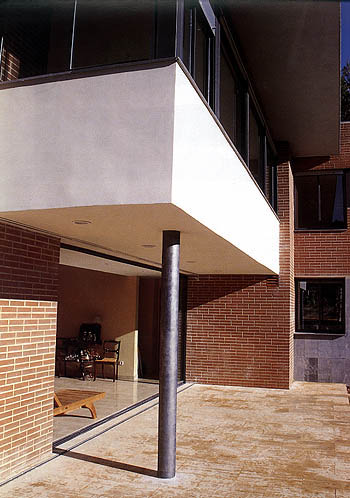
|
Promotor/Developer :Carlos Sala Palau Aparejador/Quantity
surveyor: Emplazamiento/Location: Proyecto/ Project:1997 Construcción/Built: 1998 Traducción al inglés/English translation:Gina Hardinge. |
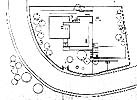 |
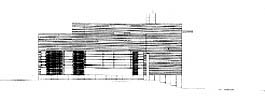 |
 |
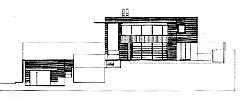 |
 |
| Alzado norte/North facade. | Alzado oeste/West facade. | Alzado sur/South facade. | Sección/Section. |